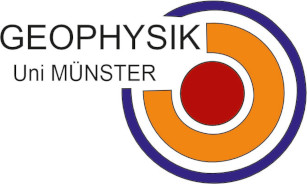

Early Earth - Magma Ocean
Magma Ocean Crystallisation
We are studying how these magma oceans cool and recrystallise. One important question, for example, is whether the emerging rock crystals are carried along by the flow (so-called equilibrium crystallisation) or whether they can settle (fractional crystallisation). Fractional crystallisation would lead to the presence of rock layers with different compositions in the mantle after the magma ocean has completely solidified, which would have a major impact on further convection in the mantle.
Magma Ocean Dynamics (Rock Crystals)
During the magma ocean period, the Earth rotated much faster than today, completing one turn in 5 hours as opposed to 24 hours today.
We investigate the influence of planetary rotation on the dynamics of rock crystals in a magma ocean by means of computer experiments in a rotating spherical shell. Our results suggest that planetary rotation may lead to the formation of large-scale chemical anomalies in the deep Earth (Maas & Hansen, 2019). These anomalies are still observed at present by seismology.

Results on the influence of planetary rotation. Without rotation (left) crystals (green) are everywhere in the magma ocean, while with rotation, depending on the rotational strength (center: slow, right: fast), they sink to the bottom in certain areas. The colors on the right denote the temperatures in the magma ocean (blue: cold; red: hot). The rotation axis lies in the direction of the z-axis.© C. Maas Further publications:
Maas & Hansen (2015), Möller & Hansen (2013), Höink et al. (2006)
Magma Ocean Dynamics (Impact-induced Metal)
After core formation impacts of small planetary bodies delivered additional metal into the magma ocean. An important question in this respect is how much of this material is incorporated into the core or remained in the Earth's mantle. To answer the question of how impact-delivered metal is mixed and distributed in a magma ocean, we employ computer models.
Our results show crucial differences in distribution and in settling history of metal depending on the impactor's target latitude (Maas et al., 2021).

Metal distribution in the magma ocean after the impact of a small planetary body with a diameter of 750 kilometers onto the early Earth. The areas in black represent the distribution of metal droplets in the magma ocean after the impact. On the left: point of impact at the North Pole; center: point of impact at 45 degrees latitude; right: point of impact at the equator. The colors symbolize the temperature of the magma ocean (blue = cold, red = hot). The rotational axis of the Earth is represented by the z coordinate.© C. Maas Newspaper article: https://www.uni-muenster.de/news/view.php?cmdid=11916
Video: https://video.uni-muenster.de/de/mp4/750_km_impactor.mp4
Mantle Convection
Layering
Planetary mantles are characterised by double-diffusive convection. There is a temperature gradient between the core and the planetary surface. Furthermore, it can be assumed that the rock material of the mantle is not homogeneously distributed. A completely different flow structure compared to purely thermally driven convection is the result.
An important process that can occur is self-organised layer formation. This is quite well understood in the area of the oceans, but for a system like the Earth's mantle, with its special and also extreme properties, very little research has been done.
Structures at the Core-Mantle Boundary
The core-mantle boundary (CMB) represents the lower boundary layer of the Earth's mantle and is structurally very complex with thermal plumes, thermochemical piles (LLSVPs) and subducted surface plates.
Our thermochemical models of mantle convection show that the presence of dense material above the CMB generally reduces the mobility of the surface plates (Trim et al., 2014, Stein et al., 2020) but that during plate evolution a variety of plume classes (e.g. line-plumes or plume clusters) occur, along with thermochemical piles and subducted plates, thus leaving a complex structure at the CMB (Stein et al., 2020).
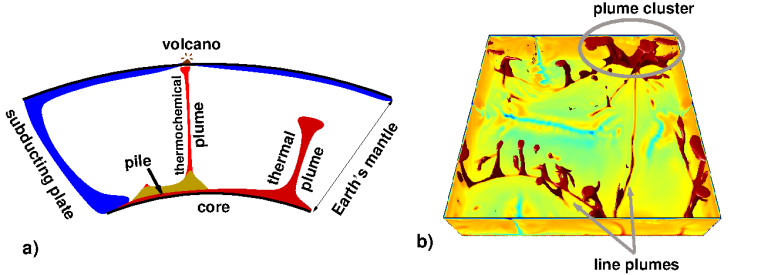
(a) Sketch of different structures at the core-mantle boundary, (b) results of a convection simulation (red: hot plumes, blue: cold, subducted plates).© C. Stein Core-Mantle Interaction
Seismologically observed features at the core-mantle boundary (CMB) possibly have a higher density than their surroundings. According to geochemical analyses these structures could stem from the presence of some core material within the mantle.
We therefore investigate core-mantle interaction as a possible origin. Our simulations show that the infiltration of iron-rich material into the mantle is coupled to the convective mantle flow. Long-lived accumulations (piles) of dense material form (Stein and Hansen, 2023).
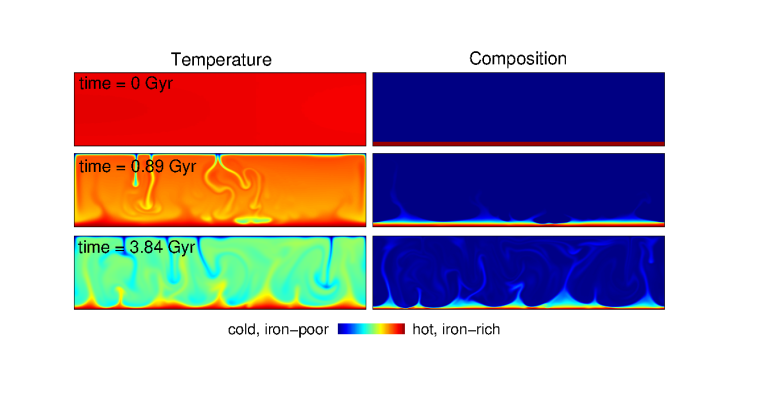
Simulation showing the temporal evolution of the temperature (left) and chemical field (right). Due to core-mantle interaction an initially iron-rich layer forms (red in composition field at 0 billion years). This layer is deformed in the convecting mantle (blue: cold sinking structures, red: hot rising structures in the temperature field at 3.84 billion years) to hot, iron-rich piles.© C. Stein
Plate Tectonics
Formation of Plate-like Behaviour
A long-standing problem in geodynamics is the incorporation of surface plates in mantle convection models. Plates have often been prescribed by the modeller (Stein & Lowman, 2010), but only by the use of a complex rheology (variable viscosity) plates form naturally as cause of the mantle flow.
Our models show that a temperature-dependent viscosity leads to a rigid, but immobile surface (stagnant lid) atop the convecting mantle. While this scenario is suited for Mars or the Moon, the moving plates and plate boundaries as seen on Earth cannot be explained. This is achieved by further adding a stress-dependent viscosity. If the stresses in the convecting flow are high, deformation of the stagnant lid is initiated and leads to subduction-like events. However, the process occurs episodically, which more resembles Venus than the Earth. A continuous surface motion is obtained by additionally considering a pressure-dependent viscosity (Trompert & Hansen, 1998, Stein et al., 2004).
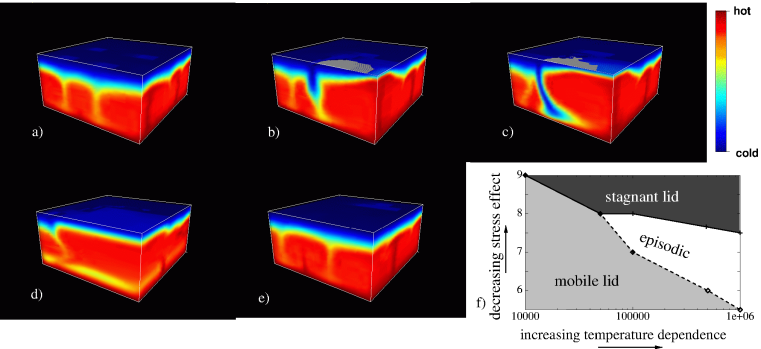
Time sequence of a plate tectonics episode shown by a modelled temperature field (red: hot, blue: cold). (a) The initial stagnant lid (blue) above the convective flow breaks up as soon as a plume reaches the surface (front corner in b). The plate (grey area in b+c) moves away from the plume and sinks. (d) Once the entire plate has sunk, subduction stops and (e) a stagnant lid forms again. (f) A strong temperature dependence of the viscosity leads to the formation of the stagnant lid, which can be (episodically) broken by increasing the stress dependence of the viscosity.© C. Stein Temporal Evolution of Plate Tectonics
We use computer models to study how plate tectonics evolved under the influence of dense structures in the Earth's deep mantle. Such structures of dense, iron-rich material have a stabilising influence on mantle flow (Trim et al., 2014).
For instance, we found that the presence of dense material delays the tectonic evolution. A mobile state similar to modern-style plate tectonics is reached later. It develops after passing through different stages: beginning from an immobile surface lid over episodic surface mobilisation (Kreielkamp et al., 2022).

Temporal evolution of the surface motion for a case with and a case without dense material present. Additionally the temperature and the composition fields are shown for the different stages of the case with dense material.© P. Kreielkamp Surface Structures in Mongolia
Central Mongolia is characterised by uplift of the Earth's surface, but is far from plate boundaries. Surface deformation within a plate is puzzling.
We use thermo-mechanical computer models incorporating available observational data. Due to a density jump, which is geologically hypothesised to occur in a thickened Earth's crust such as in Mongolia, detachment of the lower crust (delamination) occurs dynamically (Stein et al., 2022) and results in intraplate uplift of the Earth's surface as underlying mantle material rises (Comeau et al., 2021).
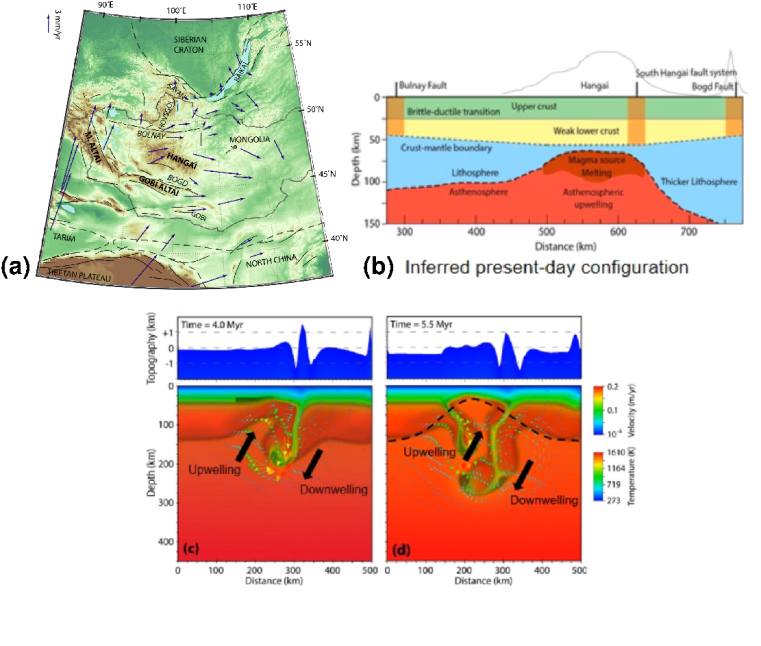
(a) Map of Mongolia with the high elevation in the Hangai region, (b) schematic illustrating the inferred present-day configuration where a hot upwelling supports the surface uplift, (c+d) modelled temperature fields (red: hot, blue: cold) showing the formation of an upwelling that leads to an elevated surface topography.© M. Comeau, C. Stein
Planetary Bodies
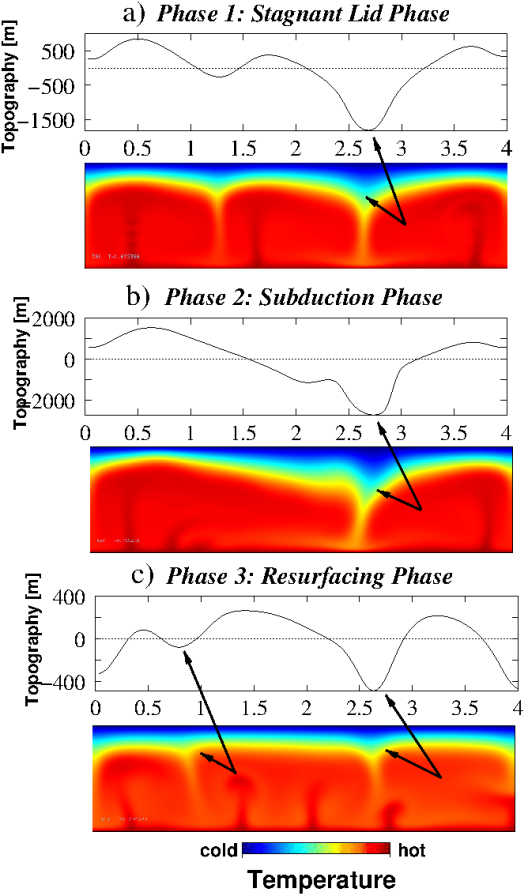
Topography at the surface with modelled temperature field (red: hot, blue: cold) at different phases of mantle convection. A negative topography correlates with sinking structures (see arrows).© C. Stein Terrestrial Planets (Mars, Venus)
Earth’s plate tectonics seems to be a unique phenomenon among the terrestrial planets. While on Earth the outer shell is split up into pieces that move relatively to each other, Mars, Mercury and the Moon are believed to be covered by an immobile surface (stagnant lid). In contrast to Earth’s continuously moving plates, Venus is assumed to have experienced global resurfacing events, meaning that phases of stagnant lid convection are interrupted by occasional mobilisation.
Another pecularity of Venus is the topography which is characterised by highland and lowland regions in conjunction with smaller crater-like structures (coronae). The highlands are large plateau-like elevations associated to mantle upwellings. The coronae seem to cluster close to the highland region and could either be small plumes deep in the mantle or instabilities detaching from the surface. Our computer models suggest that the latter assumption is more likely (Stein et al., 2010).
Further Publications: Stein et al. (2004), Loddoch et al. (2006)
super-Earths
Due to advancements in astronomical observations the list of detected extrasolar planets orbiting their parent star continues to increase. Mostly, these newly discovered exoplanets have masses comparable to Jupiter's, but the number of planets with masses close to that of the Earth is also increasing. These super-Earths are considered to have an interior structure similar to Earth and therefore might resemble the Earth's surface expression. Computer models are well suited for a systematic analysis of various parameters scaling with planet mass.
Further publications: Stein et al. (2011), Stein et al. (2013)
Icy Moons
Subsurface oceans may be prevalent in the icy worlds of the outer solar system. Gravity measurements and surface features indicate that the icy shells are decoupled from the interior. Direct imaging of erupting plumes on Enceladus from Cassini and on Europa from Hubble Space Telescope, as well as magnetic field and plasma wave observations from Galileo point to subsurface water sources. These subsurface oceans are almost certainly salt to some degree, and this gives rise to the possibility of layering by the process of double-diffusive convection.
We aim to answer questions such as whether convection and perhaps plate tectonics are possible on the ice moons, and whether transport across the ocean is efficient and how ocean circulation can be related to the surface observations (Wong et al., 2022).
Ocean Dynamics
Salt Finger
under construction

